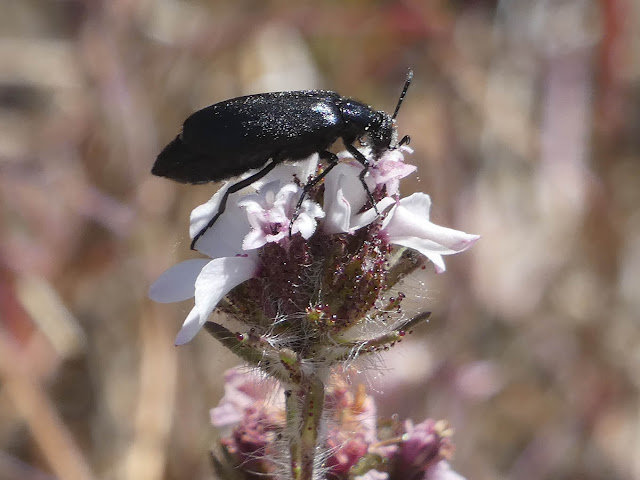 |
| Cataract Trailhead at Rock Spring |
Riding my bike over the bone-chattering surface of the boardwalk parallel to Coyote Creek is a price I willingly pay to avoid having to tangle with vehicle traffic on the approach to Tamalpais Valley. I stand on my pedals and coast as much as possible, and as I scan for shorebirds I'm also looking forward to reaching the end of the boardwalk. If it's windy enough on the way home, as it was yesterday, I can usually pedal across Highway 1 to the boardwalk and coast all the way until it reaches the smooth bike path behind the Holiday Inn Express.
It's been a while since I stopped along the boardwalk to photograph something of interest, whether willets in the salt grass, or black-necked stilts foraging in the shallow, brackish pools along the way. As I was noticing all the golden spaghetti-balls of dodder on yesterday's ride across the boards, I saw another plant that made me stop. Was that Castilleja? In the salt marsh? When I stopped I realized there were other interesting plants flowering among the salt grass and pickleweed, although the alleged Indian paintbrush was still just in bud. There was a lot of plant diversity going on in that marsh that I'd never noticed before.
Higher up and above the fog, I was struck by the diversity of grasses flowering along the edge of Panoramic Highway. I wanted to stop to photograph them all, but immediately I realized it wouldn't be possible in the wind.
More and different grasses greeted me up near Rock Spring, and on the dry hilltop near my trail cameras I was greeted by countless yellow mariposa lilies. Flying insects buzzed everywhere, and clouds of ladybird beetles opened their wings to drift on the breeze, with musical accompaniment provided by the constant buzz of stridulating crickets and grasshoppers.
Newly minted butterflies fluttered in the sun, and dragonflies patrolled their territories. Fence lizards scuttled and pumped push-ups on rocks and logs. Plant growth was running riot, and as I was about to follow a deer trail through marshy sedges to get a better angle on the first and only blooming leopard lily, I decided to find a different route when I saw all the stinging nettles rising in their midst.
At times I found myself hiking through chest-high grasses, and I picked a bunch of seeds out of my socks when I got home. Somehow I didn't get a single tick on me. The sun baked my feet inside my hiking shoes, and I sought shade wherever I could. In about an hour I'd finished all the water I'd brought (I refilled for the ride home at Pantoll Ranger Station).
I like warmth, but don't care much for real heat. So many years in the cool climate of San Francisco, I suppose. But even though I miss the fresh coolness of spring's season of rejuvenation, I do appreciate the summer -- despite its heat, insects, prickly seeds, stinging nettles, and poison oak -- for its season of bounty.
 |
| I recognized the spaghetti-like dodder (Cuscuta salina), one of four species of this strange, parasitic flowering plant found in Marin County, but it was the circled "paintbrush" that made me stop. The foreground plant with the longer green leaves at its base was also blooming with tiny flowers. |
 |
| I spotted a small patch of windmill pink (Silene gallica) along Panoramic Highway that I'd probably have missed if I'd been driving. |
 |
| I don't usually see spotted petals on farewell-to-spring (which is also usually bigger), so these might be winecup clarkia (Clarkia purpurea, ssp. quadrivulnera). I was surprised to find only two clarkia species listed in the Marin Flora (C. elegans and C. concinna). |
 |
| A black blister beetle feeds on rosinweed (Calycadenia multiglandulosa). I could smell the rosinweed coming up a couple of weeks ago, even before it started flowering. It is the scent of summer on Mt. Tam. |
 |
| Several grappletail dragonflies stayed close to the water along Cataract Creek. |
 |
| I don't know what these fence lizards were doing, but I suspect it was something territorial rather than sexual. Note the very different skin patterns on these two. |
 |
| I think I found the source of all those munch-marks on the petals of the yellow mariposa lilies.... |
 |
| Collecting pollen. |
 |
| I'd seen a few leopard lilies blooming along Panoramic Highway on the way up, but this was the only flower in bloom among many buds in a marshy spot near Cataract Creek. |
 |
| Guessing these are some kind of flower longhorn beetles (possibly Anastrangalia laetifica), here in side-view... |
 |
| ...and here in top view. |
 |
| The hummers really wanted to drink nectar from the lone lily, but they were so skittish that they flew away as soon as they noticed me. See this post for better pix. |
 |
| Rock, lichen, ferns, and lizard (growing the tip of its tail back) -- an ancient scene from the world of nature long before human beings came along. |
 |
| A California sister butterfly perches in the sun. |
 |
| View toward San Francisco from Mt. Tamalpais. |
* * *






























































